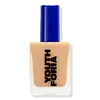Youthforia Date Night Skin Tint Serum Foundation Versus Estée Lauder Double Wear Stay-in-Place Foundation
What's inside
What's inside
 Key Ingredients
Key Ingredients

 Benefits
Benefits

 Concerns
Concerns

No concerns
 Ingredients Side-by-side
Ingredients Side-by-side

Water
Skin ConditioningTitanium Dioxide
Cosmetic ColorantCetyl Ethylhexanoate
EmollientButylene Glycol Dicaprylate/Dicaprate
EmollientDicaprylyl Carbonate
EmollientIsododecane
EmollientHydrogenated Polydecene
EmollientPolyglyceryl-2 Oleate
EmulsifyingGlycerin
HumectantPolyhydroxystearic Acid
EmulsifyingMethyl Methacrylate Crosspolymer
Magnesium Stearate
Cosmetic ColorantMagnesium Sulfate
Centella Asiatica Extract
CleansingPolyglyceryl-2 Stearate
EmulsifyingDipropylene Glycol
HumectantDisteardimonium Hectorite
StabilisingSodium Hyaluronate
HumectantSodium Acetylated Hyaluronate
HumectantHydrolyzed Hyaluronic Acid
HumectantHydroxypropyltrimonium Hyaluronate
Sodium Hyaluronate Crosspolymer
HumectantHydroxyacetophenone
AntioxidantTocopheryl Acetate
AntioxidantPropylene Carbonate
SolventCaprylyl Glycol
EmollientButylene Glycol
HumectantDiospyros Kaki Leaf Extract
Skin ProtectingVitis Vinifera Fruit Extract
Skin ConditioningAllantoin
Skin ConditioningCeramide AP
Skin Conditioning1,2-Hexanediol
Skin ConditioningCoffea Arabica Seed Extract
MaskingCarthamus Tinctorius Flower Extract
Skin ConditioningPolygonum Cuspidatum Root Extract
AntioxidantCamellia Sinensis Leaf Extract
AntimicrobialCastanea Crenata Shell Extract
Skin ConditioningZanthoxylum Piperitum Fruit Extract
Skin ConditioningMaltodextrin
AbsorbentMethylpropanediol
SolventDipotassium Glycyrrhizate
HumectantPanthenol
Skin ConditioningPentylene Glycol
Skin ConditioningAdenosine
Skin ConditioningCapparis Spinosa Fruit Extract
Skin ConditioningDisodium Stearoyl Glutamate
CleansingOlea Europaea Leaf Extract
PerfumingOpuntia Ficus-Indica Stem Extract
Skin ConditioningHydroxyphenyl Propamidobenzoic Acid
Skin ConditioningEthylhexylglycerin
Skin ConditioningAscorbyl Palmitate
AntioxidantCI 77007
Cosmetic ColorantCI 77492
Cosmetic ColorantCI 77491
Cosmetic ColorantCI 77499
Cosmetic ColorantWater, Titanium Dioxide, Cetyl Ethylhexanoate, Butylene Glycol Dicaprylate/Dicaprate, Dicaprylyl Carbonate, Isododecane, Hydrogenated Polydecene, Polyglyceryl-2 Oleate, Glycerin, Polyhydroxystearic Acid, Methyl Methacrylate Crosspolymer, Magnesium Stearate, Magnesium Sulfate, Centella Asiatica Extract, Polyglyceryl-2 Stearate, Dipropylene Glycol, Disteardimonium Hectorite, Sodium Hyaluronate, Sodium Acetylated Hyaluronate, Hydrolyzed Hyaluronic Acid, Hydroxypropyltrimonium Hyaluronate, Sodium Hyaluronate Crosspolymer, Hydroxyacetophenone, Tocopheryl Acetate, Propylene Carbonate, Caprylyl Glycol, Butylene Glycol, Diospyros Kaki Leaf Extract, Vitis Vinifera Fruit Extract, Allantoin, Ceramide AP, 1,2-Hexanediol, Coffea Arabica Seed Extract, Carthamus Tinctorius Flower Extract, Polygonum Cuspidatum Root Extract, Camellia Sinensis Leaf Extract, Castanea Crenata Shell Extract, Zanthoxylum Piperitum Fruit Extract, Maltodextrin, Methylpropanediol, Dipotassium Glycyrrhizate, Panthenol, Pentylene Glycol, Adenosine, Capparis Spinosa Fruit Extract, Disodium Stearoyl Glutamate, Olea Europaea Leaf Extract, Opuntia Ficus-Indica Stem Extract, Hydroxyphenyl Propamidobenzoic Acid, Ethylhexylglycerin, Ascorbyl Palmitate, CI 77007, CI 77492, CI 77491, CI 77499
Water
Skin ConditioningCyclopentasiloxane
EmollientTrimethylsiloxysilicate
EmollientPEG/PPG-18/18 Dimethicone
EmulsifyingButylene Glycol
HumectantTribehenin
EmollientPolyglyceryl-3 Diisostearate
EmulsifyingMagnesium Sulfate
Tocopheryl Acetate
AntioxidantPolymethylsilsesquioxane
Methicone
EmollientLaureth-7
EmulsifyingXanthan Gum
EmulsifyingAlumina
AbrasiveSodium Dehydroacetate
PreservativeDisteardimonium Hectorite
StabilisingCellulose Gum
Emulsion StabilisingPropylene Carbonate
SolventPentaerythrityl Tetra-Di-T-Butyl Hydroxyhydrocinnamate
AntioxidantPhenoxyethanol
PreservativeIron Oxides
Mica
Cosmetic ColorantCI 77891
Cosmetic ColorantWater, Cyclopentasiloxane, Trimethylsiloxysilicate, PEG/PPG-18/18 Dimethicone, Butylene Glycol, Tribehenin, Polyglyceryl-3 Diisostearate, Magnesium Sulfate, Tocopheryl Acetate, Polymethylsilsesquioxane, Methicone, Laureth-7, Xanthan Gum, Alumina, Sodium Dehydroacetate, Disteardimonium Hectorite, Cellulose Gum, Propylene Carbonate, Pentaerythrityl Tetra-Di-T-Butyl Hydroxyhydrocinnamate, Phenoxyethanol, Iron Oxides, Mica, CI 77891
 Reviews
Reviews

Ingredients Explained
These ingredients are found in both products.
Ingredients higher up in an ingredient list are typically present in a larger amount.
Butylene Glycol (or BG) is used within cosmetic products for a few different reasons:
Overall, Butylene Glycol is a safe and well-rounded ingredient that works well with other ingredients.
Though this ingredient works well with most skin types, some people with sensitive skin may experience a reaction such as allergic rashes, closed comedones, or itchiness.
Learn more about Butylene GlycolDisteardimonium Hectorite comes from the clay mineral named hectorite. It is used to add thickness to a product.
It can also help stabilize a product by helping to disperse other ingredients.
Hectorite is a rare, white clay mineral.
Learn more about Disteardimonium HectoriteMagnesium Sulfate is a salt. More specifically, it is an epsom salt, or the bath salt used to help relieve muscle aches.
Despite having ‘sulfate’ in the name, it isn’t a surfactant or cleansing agent like sodium lauryl sulfate. Unlike those sulfates, magnesium sulfate doesn’t have the same cleansing or foaming properties (it's simply a type of salt).
In cosmetics, Magnesium Sulfate is used to thicken a product or help dilute other solids. It is a non-reactive and non-irritating ingredient.
One study shows magnesium deficiency may lead to inflammation of the skin. Applying magnesium topically may help reduce inflammation.
You can find this ingredient in sea water or mineral deposits.
Learn more about Magnesium SulfateThis ingredient is a solvent. It helps dissolve active ingredients and alter the texture of products.
Propylene Carbonate is commonly used in makeup and with clay, such as montmorillonite or bentonite.
Studies show this ingredient to be safe for cosmetics. When it is undiluted, it can cause skin irritation. (It is always diluted in skincare and makeup). This ingredient is water-soluble.
Propylene Carbonate is created from propylene glycol and carbonic acid.
Learn more about Propylene CarbonateTocopheryl Acetate is AKA Vitamin E. It is an antioxidant and protects your skin from free radicals. Free radicals damage the skin by breaking down collagen.
One study found using Tocopheryl Acetate with Vitamin C decreased the number of sunburned cells.
Tocopheryl Acetate is commonly found in both skincare and dietary supplements.
Learn more about Tocopheryl AcetateWater. It's the most common cosmetic ingredient of all. You'll usually see it at the top of ingredient lists, meaning that it makes up the largest part of the product.
So why is it so popular? Water most often acts as a solvent - this means that it helps dissolve other ingredients into the formulation.
You'll also recognize water as that liquid we all need to stay alive. If you see this, drink a glass of water. Stay hydrated!
Learn more about Water